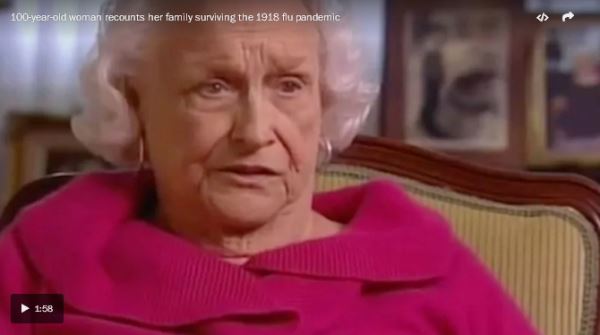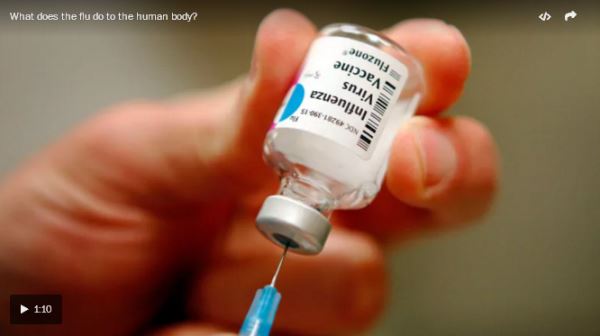The flu arrived as a great war raged in Europe, a conflict that would leave about 20 million people dead over four years.
In 1918, the flu would kill more than twice that number — and perhaps five times as many — in just 15 months. Though mostly forgotten, it has been called “the greatest medical holocaust in history.”
Experts believe between 50 and 100 million people were killed. More than two-thirds of them died in a single 10-week period in the autumn of 1918.
Never have so many died so swiftly from a single disease. In the United States alone, it killed about 675,000 in about a year — the same number who have died of AIDS in nearly 40 years.
[This flu season is on track to be among the worst in 15 years]
As the country muddles through a particularly nasty flu season — one that the Centers for Disease Control says has killed 24 children in the first three weeks of January and 37 since the start of the flu season — the 1918 nightmare serves a reminder. If a virulent enough strain were to emerge again, a century of modern medicine might not save millions from dying.
“You think about how bad it was in 1918, and you think surely our modern medical technology will save us, but influenza is the Hollywood movie writer’s worst nightmare,” said Anne Schuchat, CDC’s deputy director, at a recent seminar on the 1918 pandemic. “We have many more tools than we had before, but they are imperfect tools.”
Carts filled with the dead
St. Louis Red Cross Motor Corps personnel wear masks in October 1918 as they hold stretchers next to ambulances in preparation for victims of the flu epidemic. (Library of Congress via AP)
The flu brought life to a standstill, emptying city streets, closing churches, pool halls, saloons and theaters. Coffin makers couldn’t keep up with demand, so mass graves were dug to bury the dead. People cowered behind closed doors for fear they would be struck down.One hundred years ago, a third of the world’s population came down with what was dubbed the Spanish flu. (It got its name when the king of Spain, Alfonso XIII, his prime minister and several cabinet ministers came down with the disease.)
In Philadelphia, news stories described priests driving carts through the streets, encouraging people to bring out the dead so that they might be buried.
In New York there were accounts of people feeling perfectly healthy when they boarded the subway in Coney Island and being taken off dead when they reached Columbus Circle.
Entire families succumbed.
In Tyler County, West Virginia, John Linza, his wife and two of their sons died on the same day. Two other sons died just days before them. The last Linza, an infant, died the day after his parents.
In the southwestern tip of Virginia, J.W. Trent, his wife and two sons fell ill. They were preceded in death by all four of their young daughters — Hattie, Mary, Ellen and Ruby.
In 10 weeks, the flu killed 20,000 in New York City and produced 31,000 orphans.
A girl stands next to her sister in November 1918. The girl became so worried she telephoned the Red Cross Home Service who came to help the woman fight the flu. (Library of Congress via AP)There is debate among historians about where the flu first surfaced — did it come from China or a British encampment in northern France or rural Kansas? But it spread worldwide practically overnight.
By the end of November, 50,000 had died in South Africa, where at its peak flu killed 600 people each day. In Egypt, the death count reached 41,000 in Cairo and Alexandria by January. In Tahiti, trucks roamed the streets of Papeete to collect the dead, and great funeral pyres burned day and night to incinerate the bodies.
Normally the most vulnerable to influenza are infants, whose immune systems are not yet up to the test, and the elderly, whose ability to fight disease diminishes with age. In 1918, more than half the people it killed were in the prime of their lives.
Many died within hours, turning blue from lack of oxygen as they coughed foamy blood up from their lungs and bled from the nose, ears and eyes.
The Spanish flu infected the upper respiratory tract and then dove deep into the lungs with viral or bacterial pneumonia. How did it kill so many young healthy adults? Their immune systems attacked the influenza invader with such force that it killed them.
One Army doctor, quoted by historian John M. Barry, author of the bestseller, “The Great Influenza,” described the scene at a base hospital in Massachusetts:
“When brought to the [hospital] they very rapidly develop the most vicious type of pneumonia that has ever been seen. Two hours after admission they have the Mahogany spots over the cheek bones, and a few hours later you can begin to see [the blueness] extending from their ears and spreading all over the face. … It is only a matter of a few hours then until death comes. … It is horrible.”

Yet President Woodrow Wilson was unwilling to take any action that would compromise the war effort.
[The U.S. joined the ‘Great War’ 100 years ago. America and warfare were never the same.]
In early October, even as the disease was sweeping through military bases, killing soldiers and sailors by the thousands, U.S. Surgeon General Rupert Blue warned against rushing to see doctors with “mild cases of influenza.”
“The present generation,” Blue said, “has been spoiled by having had expert medical and nursing care readily available.”
Cowering in their homes
Then as now, the catch phrase was “a touch of the flu.” The flu rolled in every winter, enveloping people in a fog and fever that lasted a few days and lingered for a week or two. It was something to be endured, but not many people died from it.
And so it began in 1918.
To comprehend what came next — and why it is possible that a deadly strain of influenza could rear up 100 years later to kill tens of millions — requires an understanding of the disease.
The world’s most successful vaccinations against measles, polio, tetanus and small pox generally work in the same way. They introduce a minuscule amount of the disease so that if it ever arrives in full-blown form, the body will recognize and neutralize it with an immune system counter attack.
Influenza, however, never gives the immune system a stable target. Instead, it can transform itself into something that appears innocent to the white blood cells and enzymes intended to wage war against it.
That explains why a vaccine against the flu is a hit-or-miss proposition, based on the best guess of scientists about what flu strains are most likely to emerge six months later. The CDC estimates flu vaccines will be about 30 percent effective against this year’s predominant strain, H3N2, but about 60 percent effective against the other influenza A strain, H1N1, and about 50 percent effective against influenza B viruses.

In 1918 there were no flu vaccinations, and it would not have mattered anyway. After the “touch of the flu” that proved deadly only here and there during the spring, the influenza apparently mutated into a killer.
By early autumn the public face of America and the Western world had a gauze mask on it. People wore them to church, the military marched in them, police posed for photos in them and doctors wore them to visit patients. In Seattle, anyone who tried to board street cars without a gauze mask was arrested.
The masks served little purpose. The fine spray of a sneeze creates a cloud of more than half a million virus particles, and the virus can live for hours on any hard surface where they settle.
Four women who gathered to play bridge in Albuquerque in November prudently wore six-ply cloth masks. Three of them were dead the next day.
[Gen. George Patton’s wife put a Hawaiian curse on his ex-mistress. She was dead within days.]
The frightening spread of the disease led to official and self-imposed quarantines.
Schools, theaters, bars and other gathering places were ordered closed. Mothers were told their children should be confined to their own yards. In New York, officials so feared transmission on overcrowded subways that they ordered people to work staggered shifts.
Volunteer nurses from the American Red Cross tend to 1918 flu patients in the Oakland Municipal Auditorium in California, which was used as a temporary hospital. (Library of Congress)People cowered from contact with anyone who might carry the disease. A doctor in Philadelphia spoke of driving from the hospital to his suburban home without seeing another person or vehicle on the streets.
Many flu victims died in their homes of starvation, and not the disease, because they were too weak to seek food and no one dared bring it to them.
We are still vulnerable
A century later, science has revolutionized the medical profession, producing miracle drugs and surgical procedures that no one could have imagined in 1918.
But when Thomas Frieden stepped down as head of the CDC last year he was asked in an interview what keeps him awake at night.
“We always worry about pandemic influenza because this has the potential to kill so many people,” he said. “We stockpile antivirals for an emergency. But much more is needed to both track influenza better around the world and develop a better flu vaccine.”
A “touch of the flu” kills up to 646,000 people worldwide each year, sometimes as many as 56,000 of them in the United States. Since 1918, there have been three flu pandemics. (An epidemic is when an infectious disease spreads rapidly to many people. A pandemic is a global disease outbreak).
“Obviously, we still have no control over the virus,” said Barry, the historian who gave the keynote speech in 2004 when the National Academies of Science gathered to discuss pandemic influenza. “In a lot of ways, we’re arguably as vulnerable, or more vulnerable, to another pandemic as we were in 1918 because there’s more economic interdependence.”
This 2005 electron microscope image shows recreated 1918 influenza virions that were collected from a 1918 cell culture. (Cynthia Goldsmith/CDC via AP)A universal vaccine — one that will protect against every possible flu strain — isn’t expected to emerge any time soon.
“One hundred years after the lethal 1918 flu we are still vulnerable,” warned Anthony S. Fauci, director of the National Institute of Allergy and Infectious Diseases (NIAID), at a Smithsonian seminar on the 1918 pandemic. “Without a universal vaccine, a single virus would result in a world catastrophe.”
Could a 1918 scenario could repeat itself?
“It’s clear that we have a much greater capacity to respond, and we would expect to respond more effectively to a 1918-like virus, but we could have [a strain] more transmissible and more severe,” Daniel Sosin, the CDC’s deputy director for preparedness said at a recent Council on Foreign Relations forum.
One of the scant protections against another pandemic is the global reporting system that tracks emerging strains. If a 1918-like flu were to present itself, the system would, at least, alert the rest of the world to its deadly potential.
Jeffery K. Taubenberger and Ann Reid were the first researchers to sequence the genome of the influenza virus that caused the 1918 pandemic.
“The most important thing to do is not just to understand 1918 as a historical phenomenon,” said Taubenberger, an NIAID virologist, “but as an example of what could happen in the future.”
(The Washington Post)